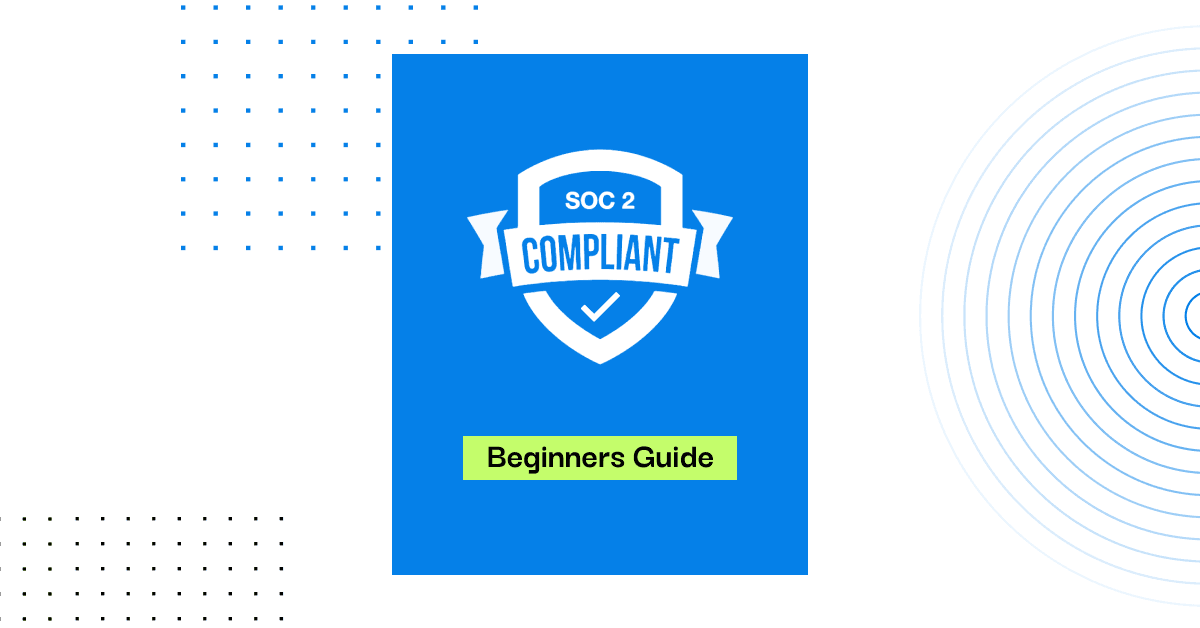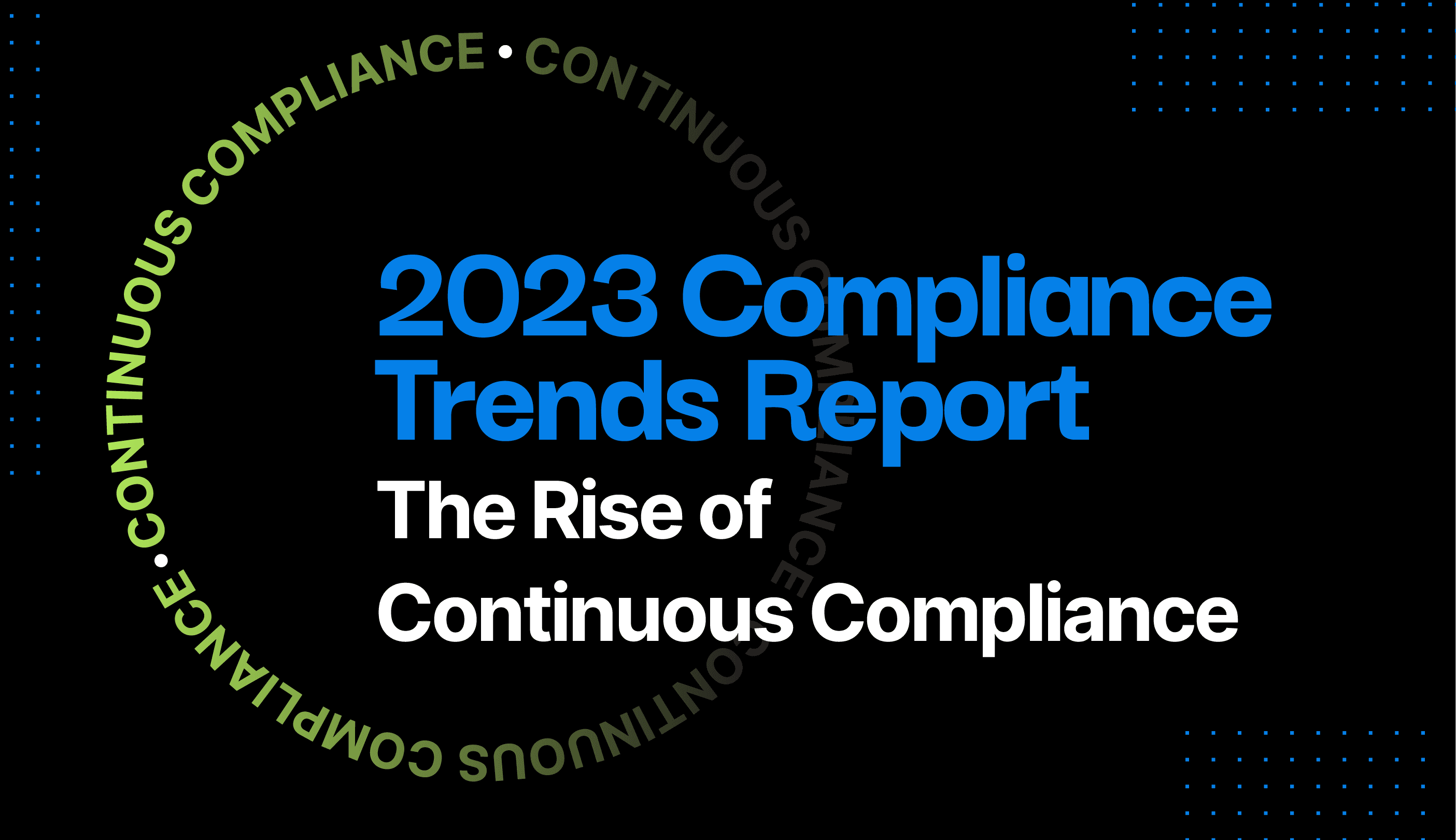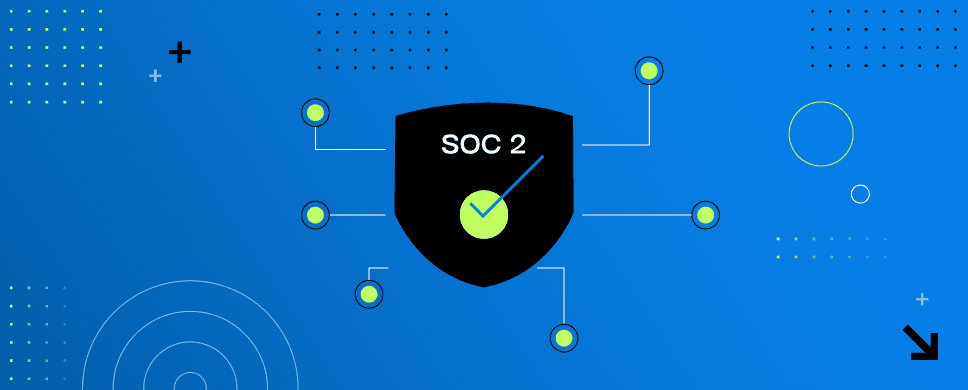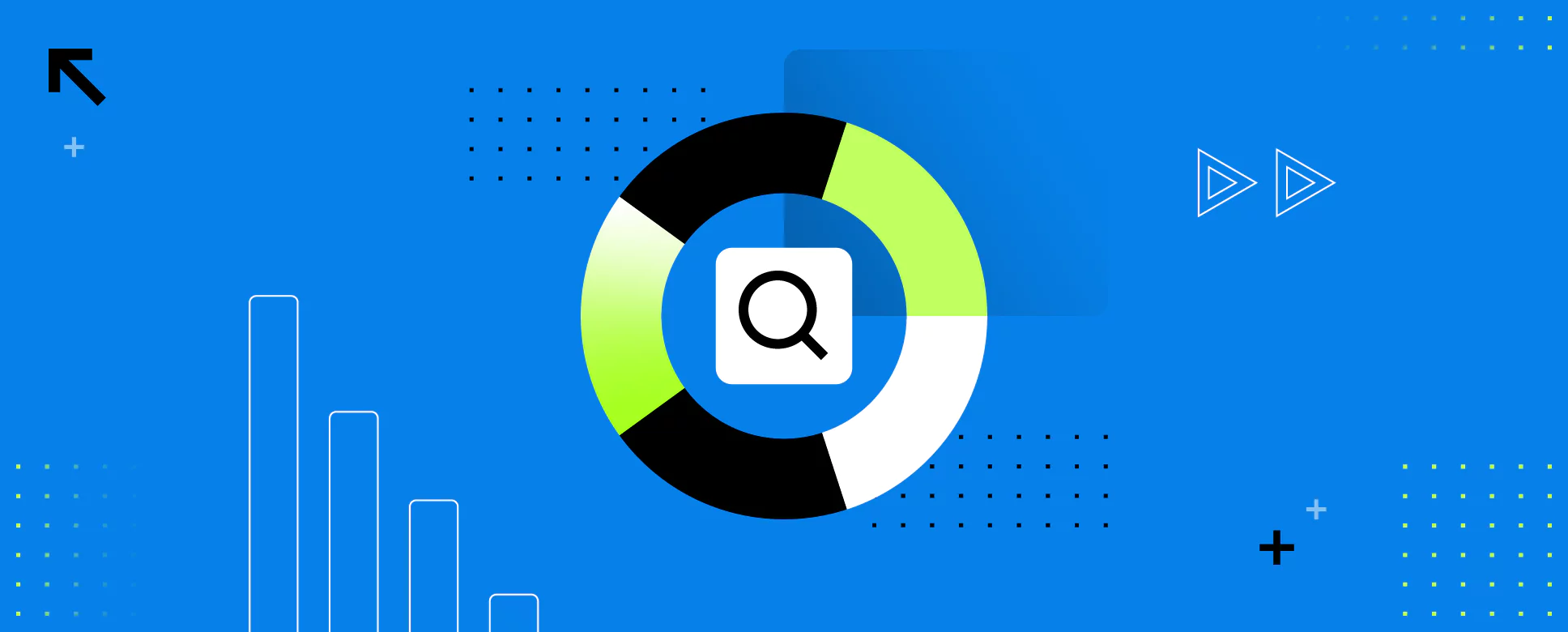What is SOC 2 Compliance? A Beginner's Guide
SOC 2 compliance is a measure of a company’s adherence to security practices. Learn how to achieve SOC 2 compliance and why it’s a competitive advantage.
SOC 2 has become industry standard (and a requirement for many) as data breaches are reported by companies around the world everyday. Customers want to know that the companies handling their data are doing so securely and taking it seriously.
SOC 2 is about meeting industry standards for security, availability, processing integrity, privacy, and confidentiality—all growing priorities for companies across a variety of industries and niches.
So, what exactly is SOC 2? And what does your business need to know about getting—and staying—compliant? We’ve compiled all of the information you need in this beginner’s guide.
What Does SOC 2 Stand For?
SOC 2 stands for System and Organization Controls 2. It’s a framework developed by the American Institute of Certified Public Accountants (AICPA) to evaluate how companies manage customer data. A SOC 2 report shows whether your business has the right controls in place to keep sensitive information secure, available, private, and accurate.
What Is SOC 2 Compliance?
SOC 2 compliance means demonstrating that your organization protects customer data according to trusted, independent standards. It’s built around five Trust Services Criteria (TSC):
Security
Availability
Processing integrity
Confidentiality
Privacy
SOC 2 compliance is unique to each company because it is a set of trust principles as opposed to a prescriptive list of controls to mark off. Every company’s security practices will look different, meaning you can achieve SOC 2 compliance with custom policies and processes that are relevant to your business’s operations.
What is a SOC 2 Audit?
A SOC 2 audit is an independent assessment of your company’s security controls, conducted by a certified public accountant (CPA) firm. The goal is to verify that your systems meet the Trust Services Criteria and that your controls are properly designed—and in the case of a Type 2 audit, operating effectively over time.
Passing a SOC 2 audit results in an official SOC 2 attestation report, which you can share with customers to demonstrate your security posture. There are two types of SOC 2 reports, Type 1 and Type 2:
Type 1 reports focus on a specific point in time and reviewing if you were compliant (e.g., were you compliant last week?). It does not review compliance over a long period of time. This type of SOC 2 report is requested less than SOC 2 Type 2.
Type 2 is the more commonly requested report because it holds more weight by reviewing a company’s compliance over a period of time (e.g., were you compliant for the last continuous year?). SOC 2 Type 2 holds companies to a higher bar because their security practice will need to be more robust and provide continuous compliance.
SOC 2 Type 1 | SOC 2 Type 2 | |
Focus | Design of controls | Design and operating effectiveness |
Timeframe | Single point in time | Continuous period (usually 3–12 months) |
Speed to complete | Faster (weeks to a few months) | Slower (typically 6–12+ months) |
Depth of evaluation | Are controls in place? | Are controls working as expected over time? |
Use cases | Early-stage validation, sales momentum | Enterprise readiness, proof of maturity |
Customer preference | May be accepted for early-stage deals | Preferred by larger customers and partners |
Effort required | Lower (initial implementation) | Higher (ongoing evidence and monitoring) |
Typically, either report will contain five sections:
An opinion letter/auditor report
Management assertion
Detailed description of the system or service being evaluated
Details specific to each of the Trust Services Criteria being evaluated
Test results from testing done on the controls evaluated
When hiring a CPA to handle your SOC 2 audit, be prepared to provide security questionnaires, documentation of your policies, practices, and security controls, and evidence that those policies, practices, and security controls are being consistently followed within the organization.
Why SOC 2 Instead of 1 or 3?
As you might have guessed, SOC 2 isn’t the only SOC around. The American Institute of Certified Public Accountants, or AICPA, developed two other types of SOC reports. All three (SOC 1, SOC 2, and SOC 3) test the same five categories, but in different contexts.
SOC 1 is solely focused on protecting clients’ financial reporting. It’s used by companies that deal heavily with finances and money, like payroll services, cloud-based billing services, employee benefits providers, and the like. If you pass your SOC 1 audit, your clients can be assured your business safely handles sensitive financial information.
SOC 2, which we’re covering in this guide, is a broader report that covers all your data security controls. There’s plenty of sensitive information that doesn’t include financials, and a SOC 2 audit tests how well you protect other data, like customer or end user information and proprietary systems. SOC 2 audits are often used by businesses that store or process information for other companies. SaaS businesses, financial institutions, and security organizations are just some examples of companies that may obtain this type of report and share it internally and with prospective clients.
SOC 3 is the public summary derived from the SOC 2 audit. You cannot receive a SOC 3 report without first completing a SOC 2 audit. The report itself is largely similar to SOC 2, with the exception that it is made to be public-facing. The SOC 2 and SOC 3 audits are identical, but a SOC 3 report does not include any specifics about your security features. However, it can be publicly released to increase investor or customer confidence.
SOC 1 | SOC 2 | SOC 3 | |
Purpose | Evaluate controls over financial reporting | Evaluate controls over security and privacy | Public summary of a SOC 2 report |
Audience | Auditors, CFOs, financial stakeholders | Customers, partners, internal stakeholders | General public |
Level of Detail | Detailed (financial controls) | Detailed (technical/security controls) | High-level overview |
Use Case | Payroll, billing, financial SaaS | SaaS, cloud providers, data processors | Marketing, transparency |
Report Sharing | Restricted (for specific customers) | Restricted (under NDA) | Publicly shareable |
Common Request For | Financial audit support | Vendor security assessments | Proof of compliance on websites |
All of these reports have their place in helping others understand that your business is secure. However, if you’re asked for a SOC report concerning security and data, it’s safe to assume what they’re looking for is SOC 2.
Why Does SOC 2 Compliance Matter?
SOC 2 is external proof of your commitment to security. As cybersecurity risks continue to rise, more organizations are dedicated to improving their security posture.
Because compliance itself is a process and you’ll need to prove that compliance over time, experts recommend making it a priority now—before you’re asked to provide a SOC 2 report.
Data Security Risks Are Rising
Hacks, ransomware, and other digital attacks are ballooning in volume. Wakefield Research and Rubrik Zero Labs surveyed over 1,600 IT and security leaders and found that 98% became aware of an attempted cyberattack in the past year (52% reported breaches, and 51% reported ransomware attacks).
That means no one is safe. Worse, 33% of respondents said their boards or executive leadership had “little or no confidence” that the business would be able to recover important data and applications after a cyberattack. With 96% of surveyed organizations suffering at least some negative consequences after a breach, executives’ hesitance may be understandable.
Attacks are costly for companies, with the average data breach costing $4.88 million in 2024. PwC’s 2024 Global Digital Trust Insights report found that 36% of companies suffered a cyberattack that cost them at least $1 million in the past year, up from 27% in 2023. With cyberattacks on an upward trend over the past two years, it’s hard to imagine the threat will diminish any time soon.
Demand for SOC 2 Reports Is Increasing Across Industries
With risks rising and awareness about data security at an all-time high, it’s no longer enough to say you have good security practices in place. A growing number of companies across a variety of industries are requiring that vendors and business partners prove it with a SOC 2 report.
This means getting your policies and controls in order and tracking your compliance religiously over time. This applies to any service provider that stores, processes, or transmits customer or client data in the cloud—which is just about all of us these days.
If you haven’t had a prospective customer ask for a SOC 2 report yet, you might think you don’t need one. For startups especially, it can be tempting to delay starting the compliance process in lieu of other priorities. But it’s really only a matter of time—we’re hearing from new customers everyday that they’ve started the process because their sales cycle stalled without one.
It’s not exactly a quick process to become SOC 2 compliant, either. It can take companies months to become SOC 2 compliant, meaning money left on the table for your company. Not to mention that most SOC 2 report requests are for SOC 2 Type 2, meaning you’re being asked to prove you have stayed compliant over a long period of time (more on this in a minute). The longer you take to become compliant, the further you can fall behind the competition.
Compliance Accelerates Sales Cycles and Business Growth
The risk of cyberattacks won’t discourage companies from using online services, but it will make security more important to savvy leaders. SOC 2 compliance is becoming a selling point for companies that process and store sensitive data in the cloud.
Enterprise companies are likely already SOC 2 compliant and therefore require similar security assurances from their vendors. Companies that wish to contract with the government must also follow strict data control procedures. SOC 2 can help your company prove it complies with Federal Information Security and Modernization Act (FISMA) and National Institute of Science and Technology (NIST) 800-171 requirements. SOC 2 can also be used to prove compliance with GDPR and HIPAA.
If you aren’t SOC 2 compliant, you’ll have trouble finding clients among organizations that must abide by any of the above standards. The good news is, because SOC 2 is a flexible standard that can be applied to companies of any size, small and mid-sized businesses can achieve SOC 2 compliance and increase their likelihood of landing the big clients that will support their growth.
Once you have your SOC 2 report, you’ll also find it much easier to prove your security credentials during the sales process. Rather than training your sales team in your security practices or bringing your IT team to meetings to prove your systems are secure, you can simply share your SOC 2 report. Potential contractors will be able to understand your security controls and see how well they performed during your SOC 2 audit.
Steps to Achieving SOC 2 Compliance
If you’re convinced SOC 2 compliance is the right choice for your company, your next move is to prepare for your audit. Don’t schedule it just yet, though. First, you’ll want to implement the necessary controls and test your systems internally to ensure your company performs well during the audit period.
Understanding the Five Trust Services Criteria
Understanding the five Trust Services Criteria (TSC) is essential to shaping your company’s security practices. We describe all five below, though only security is required for SOC 2. However, many companies will opt to include other categories in their scope depending on their industry and the types of data they process.
No matter which criteria you’re evaluating, auditors will look at how effectively your controls are operating, how quickly you respond to risks or incidents, and how clearly you communicate about risks, changes, and priorities within your organization.
1. Security
According to the AICPA standards, security means:
“Information and systems are protected against unauthorized access, unauthorized disclosure of information, and damage to systems that could compromise the availability, integrity, confidentiality, and privacy of information or systems and affect the entity’s ability to achieve its objectives.”
This means following best practices like:
Two-factor authentication
Access controls
Identity management
Encryption
Breach alerts
Maintaining firewalls
It also means having well-documented security policies and procedures, a good security training program, and enforcing best practices with your infrastructure provider and vendors, among other things.
2. Availability
Systems meet availability standards as outlined in a Service Level Agreement (SLA).
There is no set performance level required in the SOC 2 standard. When auditors evaluate availability, they’re looking at whether you keep the promises made in the SLA. For example, if you guarantee 99.95% availability, are you hitting that metric? They also review the systems you have in place to ensure performance, support disaster recovery, and manage incidents.
3. Processing Integrity
As the AICPA standards explain, processing integrity is when “system processing is complete, valid, accurate, timely, and authorized to meet the entity’s objectives.”
In simple terms, this means the systems process as expected or promised. Auditors look for good monitoring and quality assurance practices, as well as error reports and how quickly system issues are addressed.
4. Confidentiality
Data is safe from unauthorized access.
Meeting confidentiality standards typically means having encryption, access controls, and firewalls in place to protect customer data. It may also mean robust user permissions that ensure data is only accessible to those in the organization who truly need it.
In some cases, confidentiality or privacy laws like the EU’s General Data Protection Regulation (GDPR) or the California Consumer Privacy Act (CCPA) come into play here and the auditor will be looking at compliance from a legal standpoint as well as an industry standard one.
While privacy standards apply specifically to customer data, confidentiality may also include protecting clients’ intellectual property, trade secrets, and other applicable information.
5. Privacy
Personally identifiable information (PII) is private and users have full control over its use.
This piece of the compliance puzzle is particularly important in light of ever-growing data privacy regulations like GDPR and CCPA. In this category, auditors are specifically looking at how well you communicate with customers about their data. Customers should always know:
How their data is used
How they can access and update their data
Their options for opting out
Options for limiting data use
How they can delete their data, and more
You’ll also need to have practices in place to communicate with customers if there is a data breach or incident along the way.
Standards also ask auditors to look at best practices around data access, retention, and deletion. Auditors review that you monitor your privacy compliance on an ongoing basis as well as keep track of privacy-related complaints, disputes, and incidents.
How Auditors Evaluate Controls
Your SOC 2 audit will be performed by a licensed CPA firm that adheres to AICPA standards. Depending on whether you request a SOC 2 Type 1 or Type 2 report, the audit process may take between one day and six months. We’ll largely cover SOC 2 Type 2 in this article, as it’s the more in-depth evaluation and covers everything that’s in a SOC 2 Type 1 audit.
First, determine which of the five TSC you want covered in your audit. Security is the only required TSC, but you may choose to include others depending on industry expectations and/or the type of clients you’re hoping to land.
Including additional TSC will make your audit take longer, but it might be worth the delay. For instance, a business that offers payment processing for e-commerce may benefit from proving reliability, whereas a platform used for business functions that aren’t time-sensitive may care more about confidentiality.
An external auditor will inspect your company’s tech stack, data flows, infrastructure, business processes, and people. Walkthrough meetings are common, as auditors will need to observe your system in action to ensure all the promised controls are in place. Make sure your documentation matches the reality of your security processes to avoid any surprises during the audit.
Auditors may require access to internal data and documents that describe your security setup. They are also likely to request access to random samples of your data or employee population to ensure your controls are operating as designed.
Once an auditor has thoroughly inspected each TSC you chose to include, they’ll put together the final SOC 2 report.
SOC 2 Implementation Best Practices
To prepare for your SOC 2 audit, you’ll want to do a readiness assessment that covers the same scope of TSC you want your final report to include.
Our SOC 2 Compliance Checklist goes deeper into the frameworks and criteria you can expect your SOC 2 auditor to test your company against. After reviewing these standards and self-assessing against them, you’ll know where the gaps are in your process. Gap remediation typically consists of:
Developing or expanding policies and procedures that your company is missing.
Changing workflows as necessary to improve your risk management.
Implementing or updating internal controls and security measures.
Training your workforce on new policies and practices to ensure your plans are properly implemented.
After your gap remediation process, it’s time for another internal assessment to ensure the changes you made had the desired effect. If they didn’t, you have another chance to remediate your policies and processes before the official audit.
By this point, your company should be SOC 2 compliant—it just won’t be proven until your audit has been completed and the report issued.
Who Needs SOC 2 Compliance?
SOC 2 compliance isn’t required under any laws or regulations, but from a business perspective, it’s an essential part of preparing for growth and success.
Industries and Businesses that Benefit from Compliance
SOC 2 compliance will help businesses that deal with client data to prove their commitment to security and other TSC criteria. Because SOC 2 reports include details of your security systems, most companies that seek compliance are B2B service providers.
An attestation will be useful for:
Healthcare providers: Hospital systems, electronic medical record providers, and telemedicine providers, among others, have a large amount of patient data on hand. These companies are all required to comply with HIPAA, but SOC 2 adds another layer of surety that individuals’ sensitive medical data will stay protected.
Financial institutions: Banks, payment processors, insurance companies, and the like are responsible for personal data that can cause catastrophic problems if leaked. Individuals’ financial and know your customer (KYC) information can be used by bad actors to make unauthorized charges or even commit identity theft if it’s revealed in a breach.
Managed service providers: Security services, IT support, and business intelligence services all have access to sensitive company data and systems. A breach at any of these companies could allow the hackers to compromise other companies or undermine their operations.
Cloud service providers and data centers: These companies might store data ranging from a D2C business’s customer information to a government contractor’s personnel data. A breach of a cloud provider could therefore be hugely damaging to its clients and open them up to further exploitation by bad actors.
B2B or B2B2C SaaS companies: SaaS providers typically hold proprietary data, whether that’s a company’s sales pipeline or creative assets and IP that are covered by an NDA. If this information were made public, it would provide a serious advantage to that company’s competitors and potentially scuttle upcoming campaigns or growth plans.
Education providers: Companies that augment our school system, like asynchronous learning platforms, online exam tools, and class management software, are all covered by regulations including FERPA and PPRA. SOC 2 compliance can help prove their adherence to these policies and protect the data of minor students.
Along with the above categories, any company that operates in a heavily regulated space or stores sensitive PII will benefit from being able to prove SOC 2 compliance.
Business Scenarios that Require Compliance
Compliance may also become a bigger concern at certain points in a business’s lifecycle. Your company may naturally evolve a need for SOC 2 attestation as it continues to grow and develop.
Scaling operations: As companies move from startup to scale-up, it’s common to finalize and document practices that have become unofficial operating procedures. This is a natural point to seek SOC 2 compliance—you don’t want your growth to come at the price of security. Conducting a gap analysis and remediating any bad practices before they get baked into your operations is a smart choice for forward-thinking leaders. Plus, the bigger your revenue, the more likely you are to be targeted by bad actors hoping for a big payout.
Entering new markets: Companies looking to break into markets or industries that are more heavily regulated will do well to provide their SOC 2 compliance before they launch marketing or sales initiatives. While lesser security measures may seem sufficient for businesses that don’t handle sensitive information, they won’t translate well to any industry that is responsible for confidential business or customer data.
Meeting customer demands: As your customers scale and expand, they may also realize the need for better security measures and pass those requirements on to you. SOC 2 compliance may become a necessity for keeping existing clients or landing new ones. Consumers expect security, with 66% calling data breaches “unacceptable” and 86% believing it’s a business’s responsibility to protect customer data, according to PwC. This demand is percolating upward as businesses compete for their loyalty. If adherence to stricter security measures is a selling point for your clients, it will be one for you as well.
SOC 2 Compliance Risks and Best Practices
Meeting SOC 2 standards is a time-consuming challenge—and if you don’t have the right tools in place to monitor, alert, and automate, it can be hard to keep up with. For companies that do stay compliant, the secret sauce starts with these best practices:
Prioritization
If compliance is a priority (and with more and more companies requiring it, it should be), that priority needs to be built into your teams’ schedules, priority lists, and budgets from the top down. If it’s an afterthought, it won’t get done.
Consistent, Gap-Free Monitoring (Continuous Compliance)
When it’s time for your audit, you typically have to prove you met SOC 2 compliance requirements for the last year. This means 24-7 monitoring is essential and you’ll need proof of that monitoring to share with your auditor.
Security Incident Alerts
Keeping systems secure (and therefore compliant) means catching and resolving security threats fast. To do this, you’ll need to set up system alerts for things like unauthorized file transfers, account logins, or access or modification of data, controls, or configurations.
Detailed Reports of Incidents
Incidents happen to the best of us. What matters for compliance is transparency: what happened, how it was resolved and how quickly, what systems were impacted, and how major was the incident? Make sure you have detailed records and evidence that shows how you handle incidents when they happen.
SOC 2 and Emerging Privacy Regulations
SOC 2 sits outside of government privacy and security regulations, but it can be used to prove your compliance with those regulations and bolster your claims of strong security practices.
Regulations like GDPR and CCPA control how businesses deal with customer data. Compliance with these regulations is necessary for companies looking to operate in the EU and California, respectively. Both laws seek to give customers more control over their data and sharply penalize companies that don’t comply.
Unlike SOC 2, GDPR and CCPA aren’t optional. They are legally enforceable if you operate in the jurisdictions they cover. SOC 2 mainly focuses on a business’s security practices, but by adding the Privacy TSC to the scope of your audit, you can easily include practices that map to GDPR and CCPA regulations. The latest update to SOC 2’s privacy controls means including this TSC in your audit will ensure your GDPR and CCPA compliance.
SOC 2 Compliance Costs and Timelines
Because it covers a large swath of company operations on a foundational level, SOC 2 compliance takes time and resources to build. Therefore, companies that wish for a strong attestation—especially SOC 2 Type 2—must be prepared to budget accordingly.
Typical Costs and the Factors Affecting Them
The cost of your SOC 2 audit will depend on the size of your company, the scope of your audit, and whether you’re after a Type 1 or Type 2 attestation. Because an audit must be performed by a licensed CPA, you’ll be paying for your auditor’s time and expertise. The more complex your company and the broader your needs, the more you can expect your audit to cost.
Type 1 audits are cheaper because they only require a snapshot view of your security controls. Small to midsized companies may pay between $7,500 and $15,000 for an audit, while larger businesses may find themselves paying between $20,000 and $60,000.
Type 2 audits are much more in-depth because they certify that your security controls operate as expected over an extended period. Small to midsized companies can expect to pay $12,000 to $25,000 for such an audit, while larger companies should budget between $30,000 and $100,000.
Some companies will need to budget for costs outside of the audit itself. If you’ve never undergone a SOC 2 audit, your first step will be your internal assessment. This will require your employees to spend time and resources evaluating and building out your systems and practices.
You may also want to hire an outside consultant to conduct penetration testing. The cost of software to strengthen your security posture or automate your compliance efforts can add up as well.
Timelines for Type 1 and Type 2 Compliance
The timeline for your SOC 2 audit will also depend on whether you choose Type 1 (shorter) or Type 2 (longer). The long timeline of SOC 2 attestation leads many companies to first seek a Type 1 report, which they can issue as an assurance as they work toward Type 2 compliance.
Drata found, in a 2023 study, that companies spend an average of 4,300 hours yearly to achieve or maintain SOC 2 compliance. This number may increase or decrease depending on your organization’s size, the complexity of your operations, and the scope of your audit. If you’re starting from scratch, plan around six months for your internal, pre-audit efforts. Organizations that already have a strong security posture may not end up needing the entire period. However, it’s best to give yourself sufficient time to find and remediate any issues.
The audits themselves also take time. A Type 1 audit can be completed within two months or less. A Type 2 audit, on the other hand, typically ranges from six months to one year. After the audit, the auditor also needs two to six weeks to prepare the final report.
Simplifying SOC 2 Compliance
If this sounds pretty overwhelming, we hear you. Becoming SOC 2 compliant is a complex, time-consuming process for most companies. And we have been there.
In fact, the reason we started Drata in the first place is that we were the people responsible for compliance at our previous jobs, so we know how complicated, frustrating, and lengthy the process can be. And we wanted to find a way to make it simpler. Drata is the result of the simplification.
Automated 24/7 monitoring, real-time alerts, evidence collection, security training, simple dashboards and reports, and dedicated support from compliance experts—everything we do is designed to take as much burden as possible off your teams while maintaining compliance.
Because once you’ve done all that work to become compliant, you’ll need systems in place to help you stay secure and compliant and prove it (which will keep you competitive).
If SOC 2 compliance is on your horizon, it’s a good time to take a look at automation with Drata. Book a demo to see how we can help your company achieve and maintain SOC 2 compliance.
SOC 2 Compliance Frequently Asked Questions (FAQs)
Below we answer common questions related to SOC 2 compliance.
How Long Does SOC 2 Compliance Take?
SOC 2 Type 2 compliance can take 12-18 months, between your pre-audit preparation work, the observation and audit periods, and the time required to issue a final report. Type 1 compliance, which is a less robust attestation, may be completed in around six months.
What Happens if I Fail an Audit?
SOC 2 audits don’t grade your organization on a pass/fail scale. Your audit report will designate your compliance as unqualified (all SOC 2 criteria met); qualified (most SOC 2 criteria met); or adverse (most SOC 2 criteria were not met).
Any time one of your security controls was poorly designed or did not perform as expected, you will receive an audit exception that specifies your lack of compliance in that area. If you have other measures in place that compensate for the failure, you may still comply with all SOC 2 criteria. If not, you’ll likely see your compliance level downgraded.
Your SOC 2 report will list out exceptions, so the more you have and the more severe they are, the less potential clients may trust you to keep their information secure.
How is SOC 2 Different from ISO 27001?
While SOC 2 focuses on an organization’s data security controls, ISO 27001 provides a data management framework to ensure security as measured by information availability, confidentiality, and integrity.
ISO 27001 has a wider scope and takes longer to implement because it requires companies to develop and maintain an information security management system (ISMS) versus requiring certain data security controls. Finally, ISO 27001 is a formal international certification, whereas SOC 2 is a U.S.-based attestation that is more flexible.
2023 Compliance Trends Report
Drata surveyed 300 established and enterprise organizations to tap the pulse of the state of risk and compliance. In doing so, we identified related trends, perceptions, and how compliance impacts the business. This year, the primary takeaway is that a mature compliance program will accelerate a business, not slow it down.








